
Epilepsy is a chronic neurological disorder characterized by recurrent seizures, which are brief episodes of involuntary movement, sometimes accompanied by loss of consciousness, caused by a disruption of the electrical activity in the brain
About one-third of people with epilepsy still have seizures even with treatment. This creates a need for new treatment options.
Cannabidiol (CBD) is a key ingredient found in the resin of the Cannabis sativa plant, commonly known as marijuana. The anti-seizure effects of CBD do not come from directly acting on cannabinoid receptors; instead, they work through various mechanisms involving ionic channels, neurotransmitter transporters, and several seven-transmembrane receptors.
Unlike tetrahydrocannabinol (THC), CBD does not have psychoactive effects, does not cause a high or serious side effects, and has a low risk of abuse.
The aim of the study was to estimate the efficacy and safety of CBD as adjunctive treatment in patients with epilepsy using meta-analytical techniques
Randomized, placebo-controlled, single- or double-blinded add-on trials of oral CBD in patients with uncontrolled epilepsy were identified. Main outcomes included the percentage change and the proportion of patients with ≥ 50% reduction in monthly seizure frequency during the treatment period and the incidence of treatment withdrawal and adverse events (AEs).
Four trials involving 550 patients with Lennox-Gastaut syndrome (LGS) and Dravet syndrome (DS) were included.
The pooled average difference in change in seizure frequency during the treatment period resulted 19.5 [95% confidence interval (CI) 8.1-31.0; p = 0.001] percentage points between the CBD 10 mg and placebo groups and 19.9 (95% CI 11.8-28.1; p < 0.001) percentage points between the CBD 20 mg and placebo arms, in favor of CBD.
The reduction in all-types seizure frequency by at least 50% occurred in 37.2% of the patients in the CBD 20 mg group and 21.2% of the placebo-treated participants [risk ratio (RR) 1.76, 95% CI 1.07-2.88; p = 0.025].
Across the trials, drug withdrawal for any reason occurred in 11.1% and 2.6% of participants receiving CBD and placebo, respectively (RR 3.54, 95% CI 1.55-8.12; p = 0.003) [Chi squared = 2.53, degrees of freedom (df) = 3, p = 0.506; I2 = 0.0%]. The RRs to discontinue treatment were 1.45 (95% CI 0.28-7.41; p = 0.657) and 4.20 (95% CI 1.82-9.68; p = 0.001) for CBD at the doses of 10 and 20 mg/kg/day, respectively, in comparison to placebo.
Treatment was discontinued due to AEs in 8.9% and 1.8% of patients in the active and control arms, respectively (RR 5.59, 95% CI 1.87-16.73; p = 0.002). The corresponding RRs for CBD at the doses of 10 and 20 mg/kg/day were 1.66 (95% CI 0.22-12.86; p = 0.626) and 6.89 (95% CI 2.28-20.80; p = 0.001). AEs occurred in 87.9% and 72.2% of patients treated with CBD and placebo (RR 1.22, 95% CI 1.11-1.33; p < 0.001).
AEs significantly associated with CBD were somnolence, decreased appetite, diarrhea, and increased serum aminotransferases.
Adjunctive CBD in patients with LGS or DS experiencing seizures uncontrolled by concomitant anti-epileptic treatment regimens is associated with a greater reduction in seizure frequency and a higher rate of AEs than placebo.
Reference:
Lattanzi S, Brigo F, Trinka E, Zaccara G, Cagnetti C, Del Giovane C, Silvestrini M. Efficacy and Safety of Cannabidiol in Epilepsy: A Systematic Review and Meta-Analysis. Drugs. 2018 Nov;78(17):1791-1804. doi: 10.1007/s40265-018-0992-5. PMID: 30390221.
Courtesy of the National Library of Medicine
Check out our FAQ
Image by adam6180339 from Pixabay